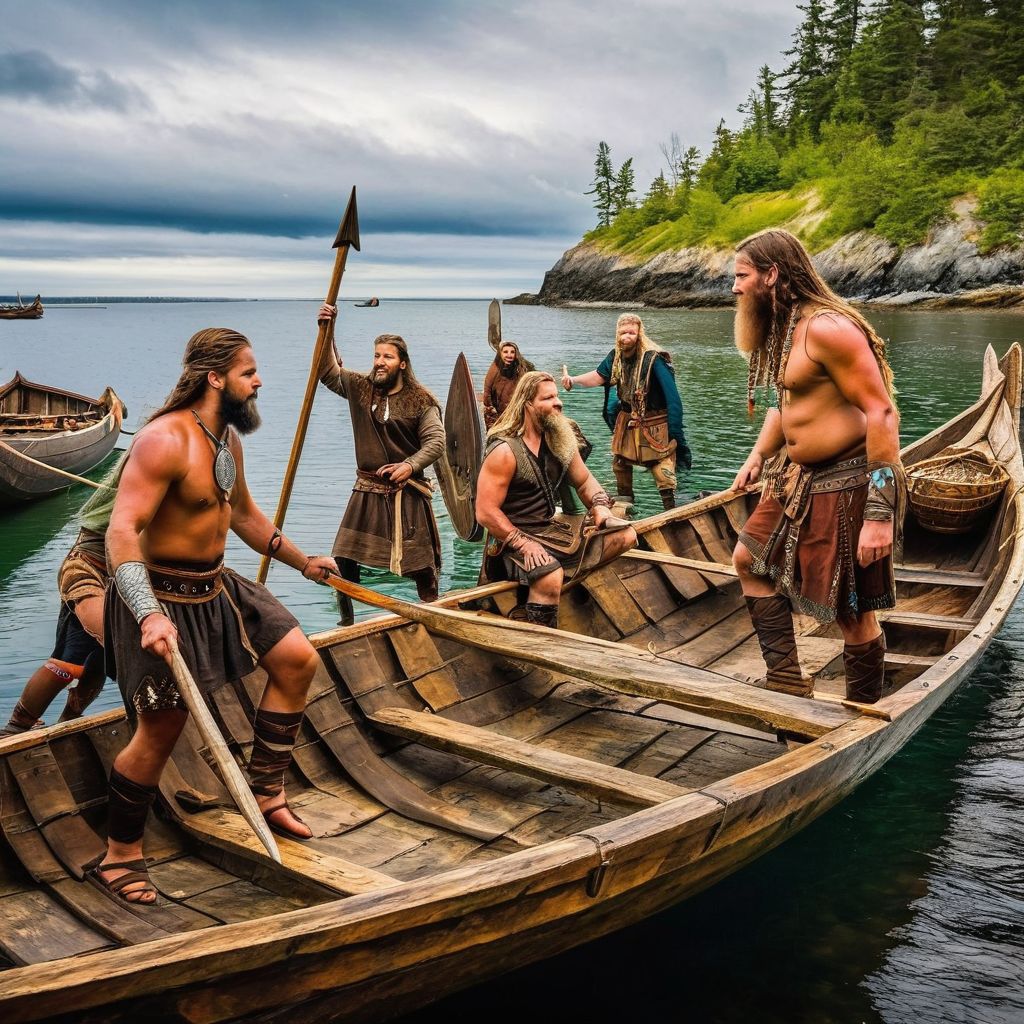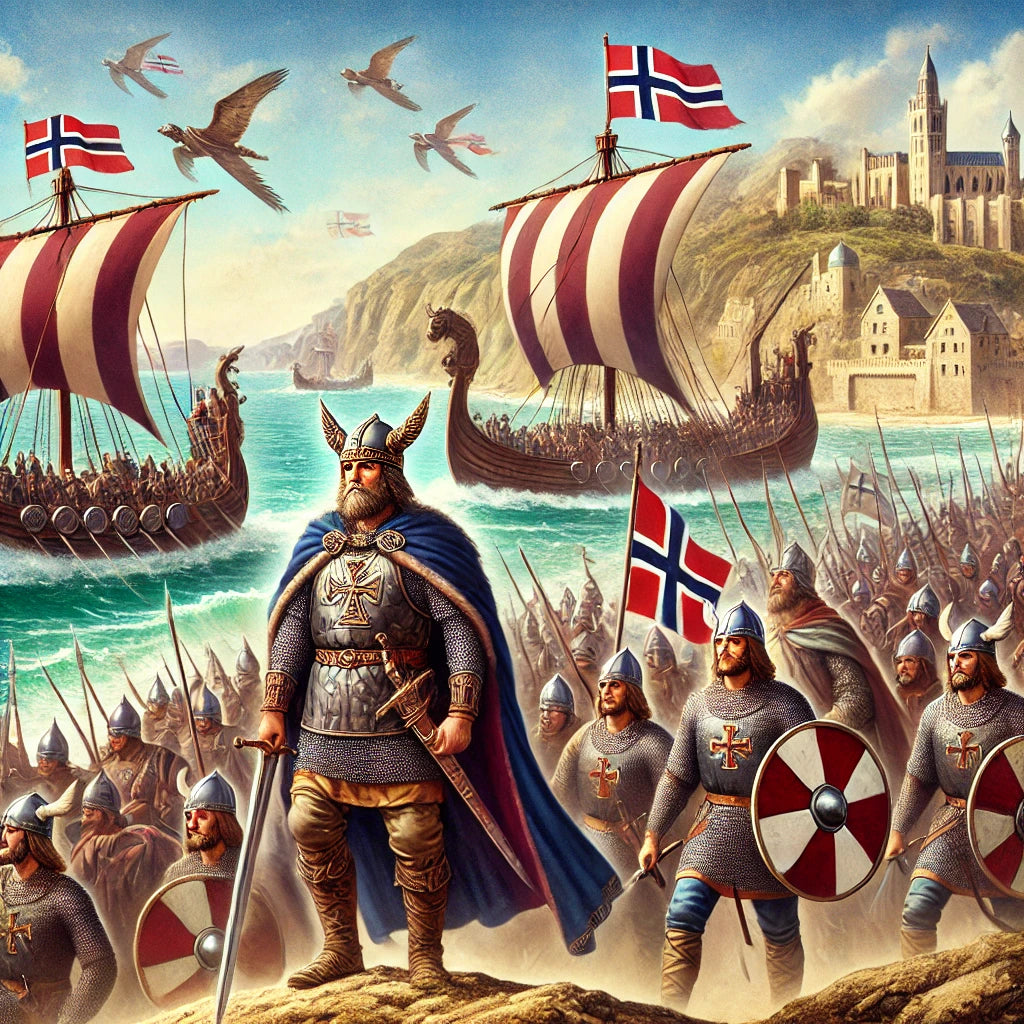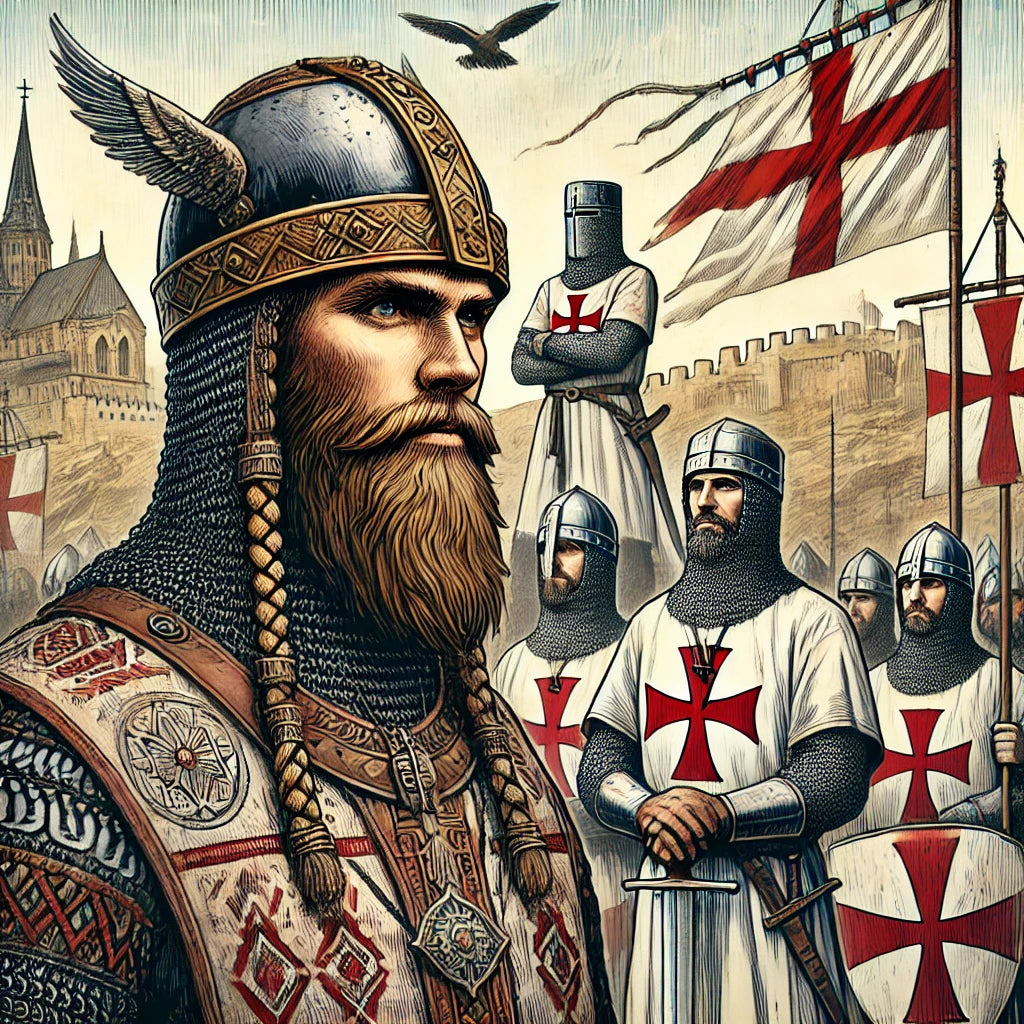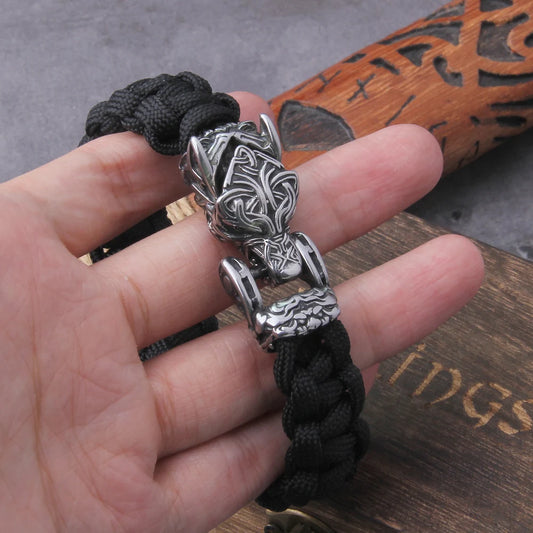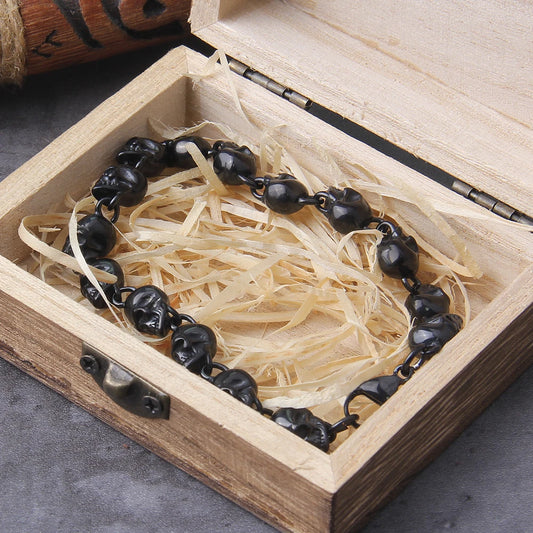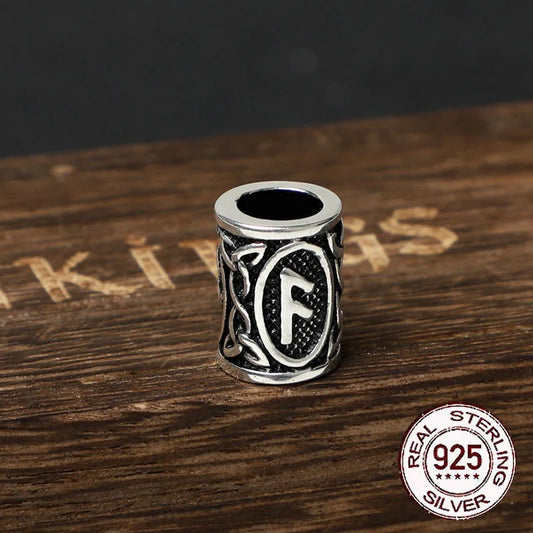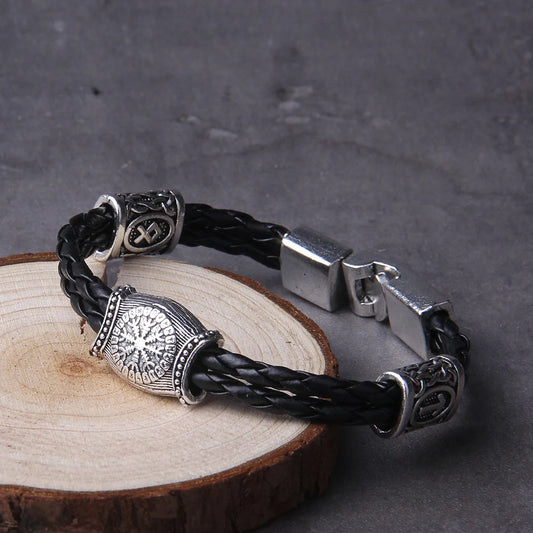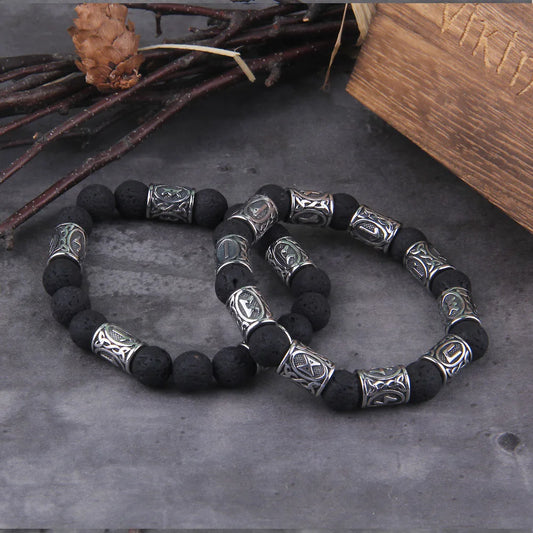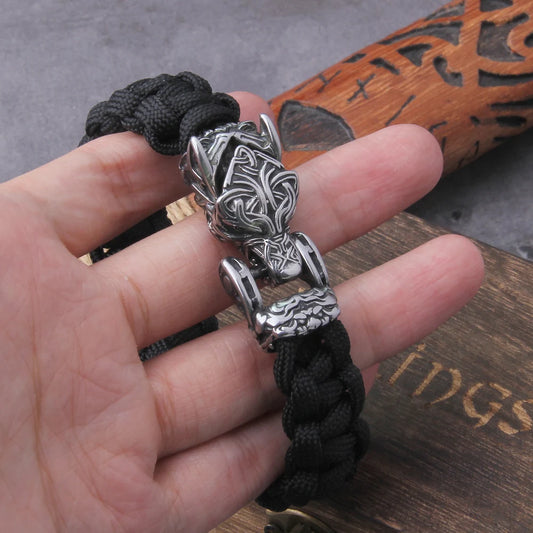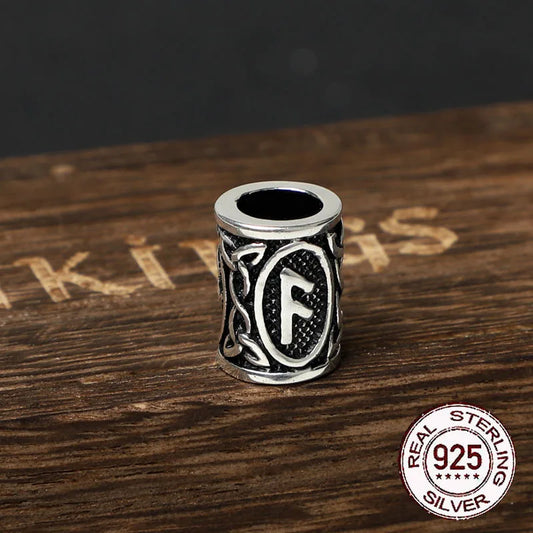The Danelaw (Dena lagu in Old English, Danelagen in Danish), as defined in the Anglo-Saxon Chronicle, is the name given to the part of Britain where the law of the "Danes" (Dane), the Viking invaders from Denmark (as well as Norway), applied and where this law superseded that of the Anglo-Saxons. Modern historians have given this term a geographical meaning: the Danelaw extended over the North and East of England.
The term Danelaw also describes the set of legal conditions and definitions created by the treaties between the English king Alfred the Great and the Dane Guthrum, established after the latter's defeat at Ethandun in 878.
In 886, the treaty between Alfred and Guthrum was formalized, defining the border between their kingdoms, with clauses for peaceful relations between Anglo-Saxons and Vikings.
Danish law prevailed in the ancient kingdoms of Northumbria and East Anglia, as well as in the region of the Five Burghs (Leicester, Nottingham, Derby, Stamford and Lincoln).
The prosperity of the Danelaw, especially the kingdom of Jórvík, made it a target for new Viking invaders. Conflicts with Wessex and Mercy undermined its power and the weakening of its military power led to its submission to Edward the Elder in exchange for protection.
Danelaw's Geography
The Danelaw occupied England north of a line from London to Chester, except for the part of Northumbria located east of the Pennines.
Within this territory, five fortified towns were of major importance: Leicester, Nottingham, Derby, Stamford and Lincoln, commonly known as the Five Boroughs (from the Old English term burg, meaning a fortified settlement of any size).
Danelaw's History
From the beginning of the ninth century, Danish offensives on the shores of the British Isles began to be accompanied by a movement of colonization.
The Danes first settled in England in 865, when the brothers Halfdan and Ivar Ragnarsson wintered in East Anglia. In 867, they moved north and, taking advantage of the civil war between the kings Osberht and Ælle, seized York, the largest city in Northumbria.
The two rivals were killed and replaced on the throne by Ecgberht, a puppet without any real power.
King Æthelred of Wessex and his brother Alfred led their army against the Danes at Nottingham, but the latter refused to leave their fortifications to fight.
King Burgred of Mercy negotiates with Ivar, leaving Nottingham to the Danes in exchange for peace for the rest of Mercy. Led by Ivar, the Danes defeated King Edmund of East Anglia at Hoxne in 869 and seized his kingdom.
Æthelred and Alfred tried once again to stop Ivar by attacking him at Reading, but they were repulsed with heavy losses. The Danes chased them, but were defeated on January 7, 871 at Ashdown.
The Danes retreated to Basing, where Æthelred revived them, but he was in turn defeated. Ivar confirmed this victory with a second one, in March, at Meretun.
Æthelred died on April 23 and Alfred succeeded him on the throne of Wessex. Weakened by the recent defeats, he had to pay tribute to Ivar in order to obtain peace.
The Danes then turned north and invaded Mercy, in a campaign that lasted until 874 and led to the fall of the kingdom and the death of Ivar. Guthrum succeeded him at the head of the troops and continued the war. In ten years, the Danes had conquered East Anglia, Northumbria and Mercy: only Wessex still resisted them.
The war broke out again in 876. The Danes seized the fortresses of Wareham and Exeter, where Alfred laid siege to them. They had to surrender after losing their reinforcements in a storm.
Two years later, Guthrum attacked again, surprising Alfred's troops who were wintering at Chippenham. Alfred was saved when the Danish army that was to catch him off guard lingered to take the fortress of Countisbury Hill, whose defenders, led by an ealdorman named Odda, crushed the Danes (battle of Cynwit).
Alfred had to hide for a while in Athelney, in the Somerset marshes, then he gathered an army in the spring of 878 and attacked Guthrum at Ethandun.
The Danes, defeated, retreated to Chippenham. Besieged by Alfred, they soon surrendered. As a condition of this surrender, Alfred demanded that Guthrum be baptized and become his godson.
The peace lasted until 884, when Guthrum attacked again, this time in Kent. Alfred defeated him and concluded a peace treaty which fixed the borders of the Danelaw and granted autonomy to the Danes in this region5.
At the beginning of the tenth century, the Danes had to deal with the children of Alfred the Great: his daughter Æthelflæd, lady of the Mercians, who recaptured Derby in 917, and his son Edward the Elder, who won a great victory over the Northumbrians in 911 at Tettenhall, annexed Mercy after Æthelflæd's death, and recaptured Essex and East Anglia from the invaders. In 918, all the Danes south of the Humber were subjected to him, and at his death, even Northumbria was occupied.
The Vikings continued their efforts in England for two more decades. In 937, Olaf Gothfrithson was defeated at Brunanburh by Æthelstan, but he returned two years later and took advantage of Æthelstan's death to recapture York and the Five Burghs.
This reconquest was short-lived: in 943, Edmund, Æthelstan's successor, took back the Five Boroughs, then York the following year. In 954, the death of Eric of the Bloody Axe, who had briefly raised the Viking kingdom of York, marked the end of the Danelaw.
Danelaw Influence on England
Number of settlers and the course of the colonization
As there are hardly any written sources on the Scandinavian colonization of the Danelaw, research has not yet reached a general consensus.
Archaeological sources can also only partially answer the open questions. The only contemporary written source mentioning the settlement of Scandinavian settlers is the Anglo-Saxon Chronicle.
The latter mentions, for the years 876 and 877, the division of lands in Northumbria and respectively in Eastern Mercy among the members of the Great Heathen Army.
For the year 892, the chronicle reports that the Grand Army embarked with horses for England and, for the year 893, that the English army got hold of all the possessions of the Danes, as well as women and children, during the attack on the camp of the Viking army at Benfleet.
The following year, it is written that the Danes moved their women to safety in East Anglia. In 896, the chronicle reports that, after the dissolution of the Danish army, part of it went to Northumbria, part to East-Angland and that the poorest embarked for new plundering in France.
When several Irish kings joined forces in 902 and defeated the Vikings in Dublin, the latter came to settle in the north-west of England7,8.
It is estimated today that the size of the Great Army in 865 was between 500 and 3,000 men.
This small number, however, should not obscure the fact that the army, composed of well-directed and combat-trained Vikings, was most often pitted against hastily enlisted peasants who had little chance of winning.
In the same way, the large army which, according to the Anglo-Saxon Chronicle, had come from the continent in two groups of 250 and 80 ships, would have numbered well under 10,000 men according to current estimates.
To explain the strong Scandinavian imprint in the Danelaw, research suggests that a second wave of immigration took place after the military occupation. However, it is difficult to provide evidence for this claim.
Linguistic heritage
The legacy of the Viking invasion is not only limited to the toponymy but also to the spoken language. At the time of the Danelaw, there was still some inter-comprehension between Old Norse and Old English, albeit weak.
This led to the incorporation of many Norse words into the English vocabulary, such as law, sky, and window, as well as the third person plural pronouns they, them, and their.
Many Norse words still survive in the dialects of northeast England.
Genetic heritage
In 2000, the BBC commissioned a team of scientists led by Professor David Goldstein to conduct a genetic investigation into the genetic impact of the Viking presence in Britain.The name of this mission entrusted to biologists from University College London was "Blood of the Vikings".
In 2001, the BBC documentary series Blood of the Vikings compared DNA samples from 2,000 Britons from all over the island with those of Scandinavians, in order to find out to what extent the Vikings had left a trace on the island.
The study showed that the Norse influence had spread throughout Britain, with the strongest sample from Penrith, Cumbria.
Northern invaders colonized more specifically certain areas of the British Isles such as Orkney and Shetland. This study focused on Norwegian colonization because the descendants of the Danes are genetically indistinguishable from the Anglo-Saxons.

